12/12/1934 – 20/07/25
Stella passed away at Dove Tree House early hours of the 20th July ……..she lived and worked in Sherbone and retired when she was 60. She moved down to Exeter when she lost her husband in 2019 to be near her daughter.
There was joy and laughter at The Malthouse residential care home in Gillingham, Dorset, on Tuesday as Valerie celebrated her 104th birthday in style—surrounded by friends, good food, and warm smiles.
The afternoon gathering marked a remarkable milestone, with guests joining Valerie for a celebration filled with laughter, love and reflection. Chef Nicki created a stunning birthday spread, complete with a homemade cake that went down a treat with everyone present.
Guests were full of praise for the care Valerie receives at The Malthouse. Many spoke about how happy and settled she seems—particularly impressive given her initial nerves about moving in. They were quick to credit the team’s warmth and compassion, describing them as committed and deeply caring.
Valerie, clearly moved by the day’s celebrations, beamed as she reflected on her experience at the home.
“It’s a home from home,” she said with a smile. “You’re all wonderful, and I can’t thank you enough for everything you do—especially for making today so special.”
It was a touching celebration for a truly extraordinary lady, and a testament to the sense of community and kindness that defines life at The Malthouse.
Here’s to Valerie—104 years young, and still lighting up every room she enters.
To find out more about Healthcare Homes and The Malthouse, visit www.healthcarehomes.co.uk.
In June, Dorset CPRE hosted a planning conference on Net Zero – North Dorset chairman Rupert Hardy reports on the discussions
The goal of achieving Net Zero homes is vital. Buildings account for a huge 39 per cent of energy-related carbon emissions, which come from their construction, operation and maintenance – they are a major driver of global warming and climate change.
In 2023, the UK government made a commitment to reach Net Zero by 2050, meaning that any greenhouse gas emissions produced must be balanced by those removed from the atmosphere. It is essential that all new buildings are designed and constructed to meet this goal.
Net Zero requires that homes must be compliant in both operational energy – the energy used for heating, lighting and daily living – and their embodied carbon, which covers the emissions generated during construction. Homes built to these standards aren’t just better for the planet, they also benefit their occupants by being constructed to higher standards and having significantly lower running costs.
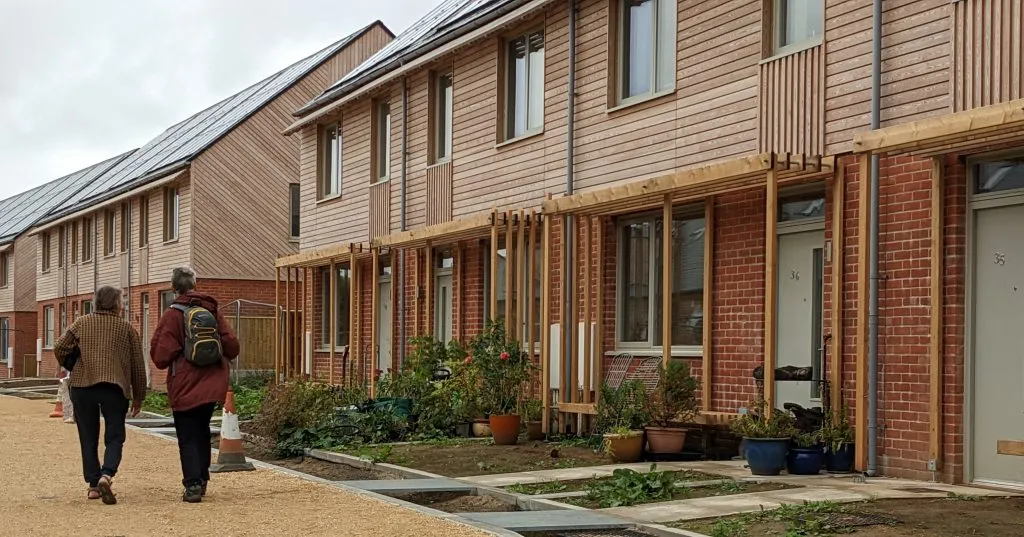
Can Dorset join the revolution?
The planning conference looked at how Dorset can rise to the challenge of ensuring that all new homes meet the Net Zero target. The event brought together industry experts, policy makers, developers and academics to discuss the latest innovations and challenges in zero carbon sustainable housing. It showcased pioneering examples of Net Zero development and tried to answer some of these questions:
What measures are needed to ensure that Dorset’s new homes meet Net Zero targets?
What policy changes and incentives are needed to support innovation in the industry?
How must construction methods change to reduce carbon emissions?
Can affordable homes be delivered that meet Net Zero targets?
Getting left behind
The conference was opened by Dorset CPRE president, former BBC Chief News Correspondent, Kate Adie, and was chaired by Dorset CPRE planning group chairman Andrew Procter whose talk, Making the Case for Zero Carbon in Dorset, set the scene by explaining why Dorset and BCP must take a proactive approach to ensuring new homes meet Net Zero targets.
He explored the opportunities for the area to become a leader in delivering Zero Carbon housing and highlighted other authorities, such as Cornwall, that have pioneered mandatory low-carbon policies for new developments.
He also questioned why so many countries across Europe are so much further ahead.
Andrew proposed that Dorset should set up a Net Zero Innovation Centre – an idea that drew enthusiastic support from many in the audience.
It happens in Bath
The second speaker was Dr Will Hawkins, Lecturer in Structural Engineering Design at the Centre for Sustainable Energy Systems, University of Bath. His talk, Pioneering Net Zero Carbon Construction Planning Policy in B&NES, examined Bath and North East Somerset Council’s groundbreaking policies, introduced in 2023. These policies require all new developments to achieve Net Zero operational energy and major developments to meet embodied carbon targets, making B&NES the first council in the country to adopt such measures.
Pioneering Bridport
Sam Goss, Founding Director of Barefoot Architects, followed with Bridport Cohousing: A Place to Grow. He shared the story of Bridport Cohousing, now named Hazelmead – a pioneering low-carbon development of 53 Net Zero affordable homes built on land crowdfunded by members. Developed to address the severe shortage of affordable, sustainable and community-oriented housing in Bridport, the project was designed to foster sociability and reduce loneliness.
Ironically, it was initially opposed by Dorset Council, but has since become a flagship example of innovation. The Community Land Trust development includes shared facilities, a large wild space and a community orchard. Most of the site is pedestrianised, with cars and tarmac moved to the edges.
It’s getting better
The final talk came from Ian Pritchett, Co-Founder and Innovation Director at Greencore Homes. A pioneer in using lime mortars in the building sector, Ian presented Better than Zero Carbon Homes Now!, and demonstrated how high-performance, low-carbon homes can be delivered today, and discussed how buildings can go even further. However, he noted that achieving this requires widespread upskilling across the industry. Greencore Homes is currently working on 500 such homes.
Rooftop solar and no heat pumps
Following the presentations, there was a round table debate on the issues raised.
The speakers were joined by:
Councillor Nick Ireland, leader of Dorset Council (DC) and cabinet member for performance, climate and safeguarding
Councillor Kieron Wilson, portfolio holder for housing and regulatory services at BCP Council
Tim Crabtree, chair Dorset Community Energy
Mark Chivers, co-founder of Zero Carbon Dorset
All the speakers gave engaging and inspirational contributions, but there was particular interest in the Hazelmead development in Bridport. Notably, Hazelmead and Greencore Homes both use direct electric heating rather than heat pumps – an approach that contrasts with current government policy. All the developments also make extensive use of rooftop solar panels, a strategy CPRE has been advocating for years as a preferable alternative to harmful greenfield solar schemes.
The round table gave leaders from Dorset Council and BCP Council a chance to reflect on the challenges and opportunities.
There was broad agreement that Dorset should follow the example set by pioneering councils such as Bath and North East Somerset by introducing standards far more ambitious than the current government building regulations. These national standards are often held back by the reluctance of large house builders to adopt them. Participants agreed that government legislation should be more supportive and proactive about decarbonising construction.

Signs of hope
Nick Ireland acknowledged that Dorset Council still has a long way to go to move on from the outdated policies in previous Local Plans. However, he expressed hope that the new – though still embryonic – Local Plan will show real progress. He also noted that Dorset Council is not currently considering using powers of compulsory purchase, describing them as “too cumbersome and too complex.”
Instead, he hopes the Council can use its own land to help meet local housing needs.
All present agreed on one thing: the urgency of the challenge, echoing Sir David Attenborough’s words: “What we do in the next ten years will profoundly affect the next few thousand.”
[ad] A trip down memory lane rekindles military memories for Grovelands resident
A chance mention of an abandoned Dorset village sparked a flood of long-buried military memories for Grovelands resident Dave, who lives with dementia.
Though Dave served in the armed forces for 22 years, little was known about his military past by carers at Grovelands, a dementia, respite and residential care home in Yeovil. That changed when a member of his care team happened to mention Tyneham Village – a moment that unlocked vivid recollections from Dave’s time in the forces.
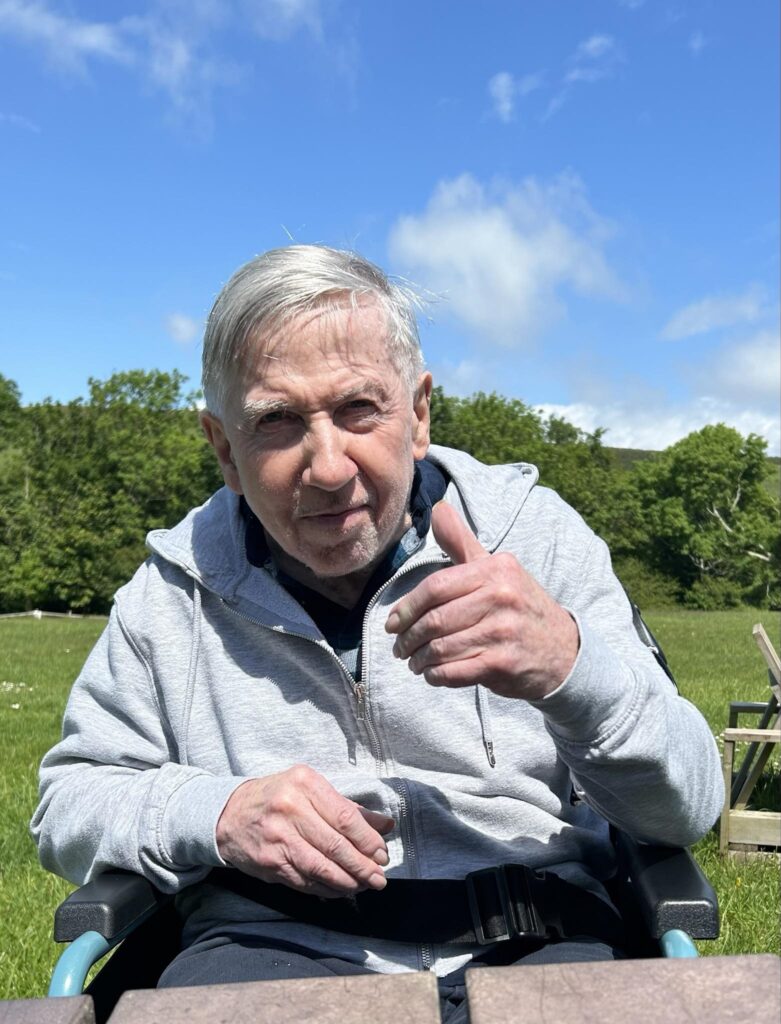
During his aviation training, Dave had been stationed at Middle Wallop airfield, not far from Tyneham, and he recalled with striking clarity flying over the village during sorties.
Requisitioned by the military in 1943, Tyneham remains part of the Armoured Fighting Vehicles Gunnery School, with public access still restricted and its original residents never having returned. Despite this, Dave’s descriptions were so detailed and enthusiastic that the Grovelands Activity Team arranged a special trip to the village in his honour.
Precious memories from a remarkable life
Dave’s time at Middle Wallop holds a deep personal significance – it was there he married his wife, Jackie, and where they lived together before welcoming their daughter, Cerys. The couple had first met while serving in Germany, later being posted together to Northern Ireland and Hong Kong, where Dave proudly recalls learning to surf.
Bringing the past to life
With plans in place, a group of Grovelands residents made the journey to Tyneham, exploring the hauntingly preserved village and helping reignite cherished memories for Dave.
Karen Cheshire, Registered Manager at Grovelands, said:
“It was a real privilege to enable Dave to return to a place which clearly means so much to him, and to watch him share his knowledge and enthusiasm for Tyneham Village with his carers and fellow residents.
We continue to be amazed and inspired by the power of revisiting a lived experience for someone who lives with dementia. Hobbies and interests have an incredible ability to ‘unlock’ a bit of the person that dementia masks in daily life, which is why we are so passionate about person-centred care which enables us to better understand and empower those we care for.
We strive to keep listening and learning about people’s lives and take every opportunity to provide meaningful activities for our residents to enjoy and be enriched by.”

Outstanding dementia care in the heart of Yeovil
Grovelands, rated ‘Outstanding’ by the Care Quality Commission, provides respite breaks, residential care and specialist dementia support in a purpose-built yet homely setting.
The home includes a dedicated dementia care suite that offers a secure and supportive environment, helping residents live as independently as possible. A varied programme of activities is designed to encourage engagement, promote wellbeing and help residents reconnect with treasured hobbies and memories.
To learn more about the specialist dementia care available at Grovelands, visit www.somersetcare.co.uk/grovelands or speak to our expert enquiries team on 0800 817 4925.
More than 400 runners are set to take part in the Sturminster Newton Half Marathon on Sunday 3rd August. Organised by the Dorset Doddlers since 1990, this year the ‘Stur Half’ is part of the Dorset Road Race League and serves as a Dorset County Championship race. For those preferring a shorter challenge, there’s also a multi-terrain 5K, open to online entries or sign-up on the day.

The annual event always has strong backing from local businesses: Honeybuns Bakery is lead sponsor, rewarding every finisher with one of their delicious cakes. Harts of Stur are sponsoring the local runner and course record prizes, Symonds & Sampson are providing mile markers, and Root & Vine will supply juicy oranges at the finish.
The Half Marathon starts at 10.30am on Station Road, outside the Railway Gardens, following a scenic route through Manston, Margaret Marsh, Stour Row and Todber before returning via Moorside and Hinton St Mary to finish as always along the tree-lined avenue to the High School.
The 5K begins shortly after, taking in roads, tracks and footpaths towards Hinton St Mary before heading back to the same finish.
Entry for the Half Marathon costs £22 for affiliated runners or £24 for unaffiliated, with a £2 surcharge for entries on the day. The 5K costs £7 whether entered online or in person.
The Dorset Doddlers also donate proceeds to local charities and organisations. Spectators are warmly encouraged to come and cheer.
For details and entries see https://www.sturhalf.co.uk
The sun shone kindly on Spetisbury Station Project’s Summer Tea Party on 13th July, helping to make the event another memorable success.
Guests relaxed in the summer warmth with chilled glasses of freshly made Pimms and homemade cream teas, accompanied by the uplifting sounds of the ever-popular Blandford Ukulele Group.

This year’s event also tied into Railway 200, a nationwide celebration marking the 200th anniversary of the birth of modern train travel in 1825. Representatives from both the North Dorset Railway at Shillingstone and the North Dorset Trailway were on hand to share information with visitors. The Trailway now offers nearly 14 miles of traffic-free, sustainable travel along the route of the former Somerset & Dorset Railway, from Sturminster Newton to Spetisbury.
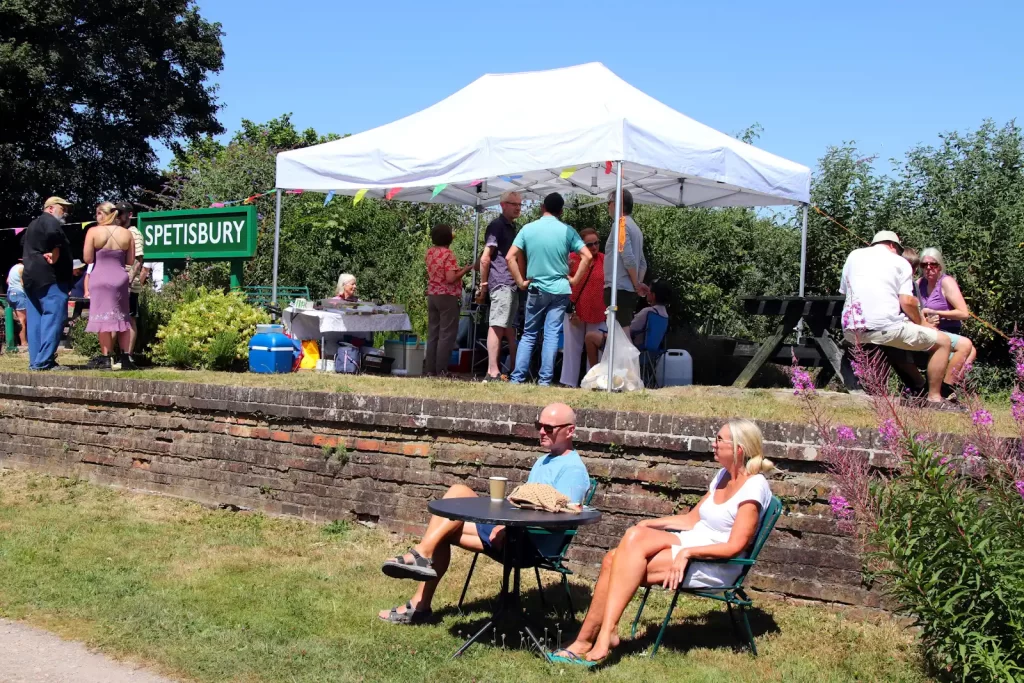
Nearly £400 was raised during the day – every penny of which will go directly towards maintaining and improving the former station for the benefit of the local community and visitors alike.
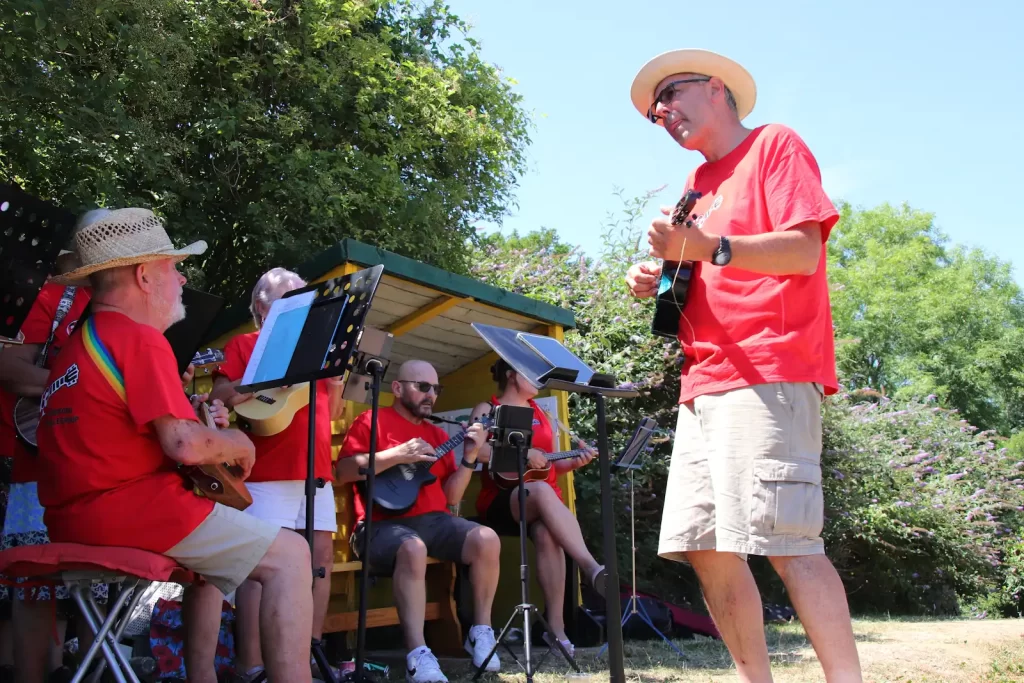
As part of Railway 200, the Spetisbury Station Project has also partnered with the Blackmore Vale Line Community Rail Partnership. It is one of 120 venues across the region offering free limited-edition postcards – collectable items that can be exchanged for gifts such as a water bottle or a rucksack.
Further details are available on the website: www.spetisburystationproject.wordpress.com.
As boys they picked blueberries on a Dorset farm and now the Benson brothers blend tradition, flowers and cafe culture at the plantation
Little did brothers Dan and Josh Benson suspect that their school holiday job picking blueberries in a field near their Dorset home would shape their futures. Today that same field is part of their aptly-named Brothers’ Farm, a flourishing pick-your-own blueberry and creative cut flower enterprise near Wimborne.
The brothers had worked summers here as teenagers, harvesting the crop without realising they would later take the reins.
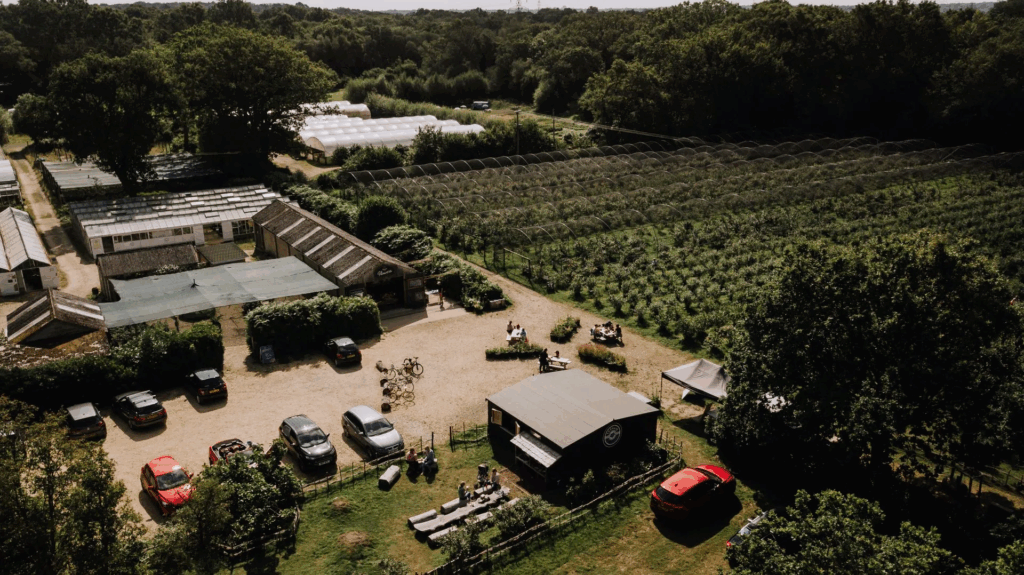
Trehane, the UK’s first (and now oldest) blueberry plantation. His first blueberries were planted in 1951 in his garden – 80 plants from Lulu Island in British Columbia, which were offered free of charge to any grower who was prepared to trial them to see how ‘high bush’ blueberries would perform in this country. They thrived, and in 1957 David planted a whole acre, about 1,000 plants, following with the larger field in 1964. Over the decades, many thousands of visitors came to pick their own berries, and Trehane blueberries gained a loyal following.
After university, Josh Benson qualified as a tree surgeon, and his brother Dan trained in landscape architecture and joinery and worked in London. ‘My wife and I had two youngsters and were living in a one-bedroom flat in London, with us both sleeping on the sofa with the kids in the bedroom. It was a great time up there but, in the end, we just needed more space,’ says Dan. The ‘home of the British blueberry’ was calling, and after seven years of leasing the land, the brothers were eventually able to buy it in 2022.

The grassy bog blooms
With the warm weather ripening the burgeoning organic blueberry crop, their busiest season of fruit picking is fast approaching. The window is short: they have just six weeks to harvest, sell and freeze for next year. This time pressure coincides with increased demand for their other venture – cut flowers. Bouquet orders for summer weddings and events combine with an influx of visitors to their beautiful flower barn seasonal café.
Dan, pencil behind ear, hands grimy with soil and a list of a 1,000 jobs to do, breaks off to chat. Brother Josh is busy in the far field, training protégé Stuart.
Dan has been at the farm since early morning and has already cut more than 300 flower stems. What was once a grassy bog now blooms with colourful rows of phlox, dahlia, delphinium, nigella, salvia, cornflowers and perfect poppies. Behind this floral cornucopia are rustic picnic tables. Visitors are welcome to enjoy coffee and cake in the peaceful flower field.
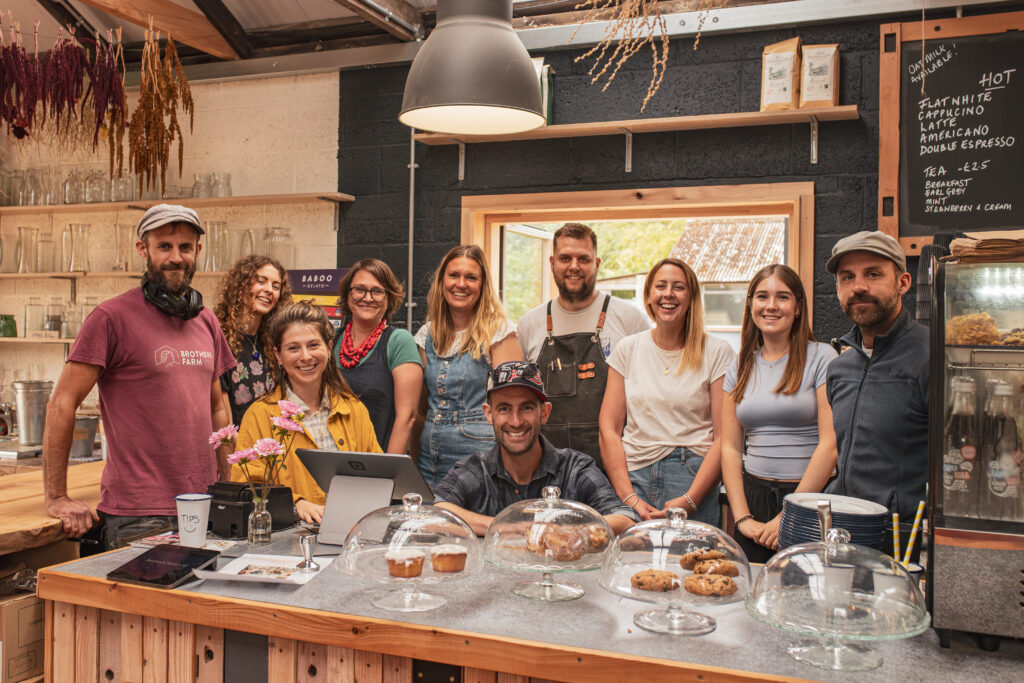
‘This bit of land was buried under brambles and scrub a few years ago,’ says Dan. ‘I decided to plant a few flower seeds and it’s grown … literally!’
Dan’s sophisticated spreadsheet keeps track of the varieties he grows (at last count that included 15,000 seeds), ensuring a steady seasonal supply of cut flowers.
Their talented resident florist Becca Franklin then works her magic to devise sought-after wedding bouquets. ‘When people visit and see where, and how, the flowers are growing, they understand we can only offer what we grow and what’s in season. We don’t import any flowers. It’s very much field to florist – and that’s about six metres!’
The last few years have seen the conversion of an old potting shed into a rustic flower barn café, the ceiling artistically adorned with sprigs of dried flowers: all the handiwork of the brothers, who seem able to build, grow, mend and repair anything. Dan’s wife Cecily upholsteredthe bright lime and blue chairs.
The barn is home to a thriving flower workshop, offering year-round flower arranging courses and a sell-out flower club.
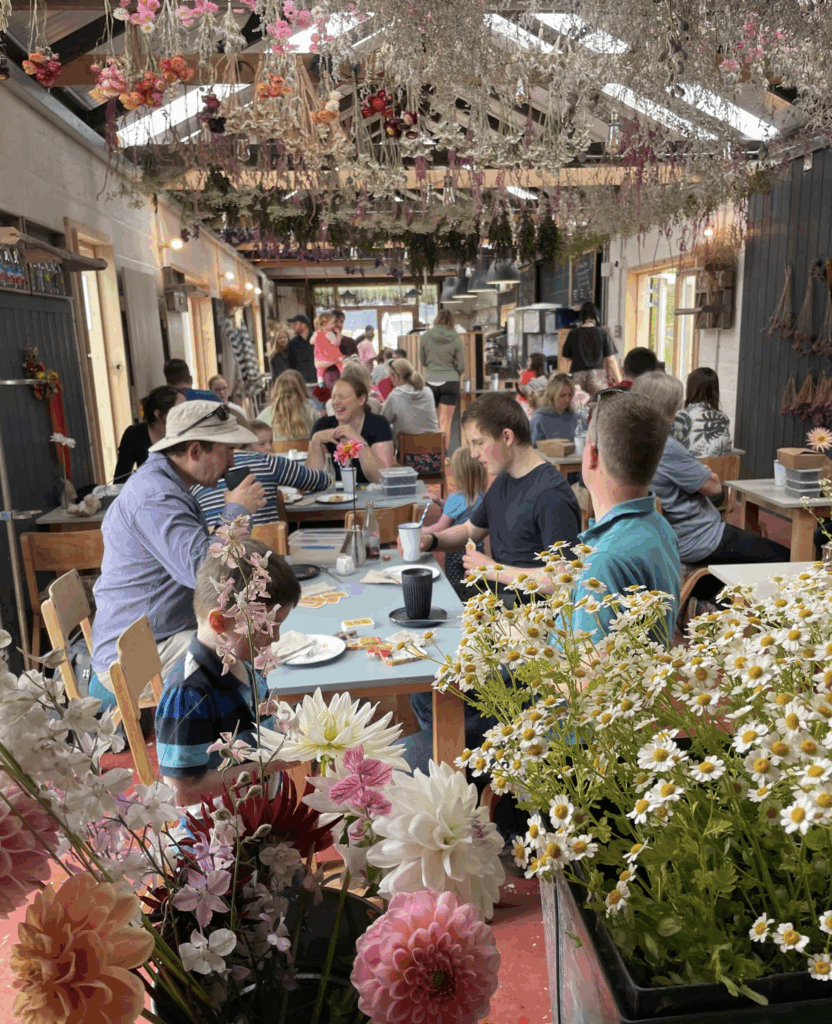
‘We’ve come a long way, from just me and Josh and one temperamental coffee machine in a shed shared with all our tools,’ says Dan. ‘We’re now open all year round and employ a wonderful team of people led by Fran in the Flower Barn helping us run the café and workshops, while we brothers manage the fields and Becca manages the floristry business.
‘We feel responsible for the legacy. That’s partly why we’ve kept the Trehane name for the blueberry business.
‘But we feel that all the changes we’re making will secure the future of the fields for generations to come.’
As the blueberry picking season kicks in, a host of summer workers swell the ranks.
Who knows – this crop of school-leavers may follow in the Benson brothers’ footsteps and be the next rural entrepreneurs.
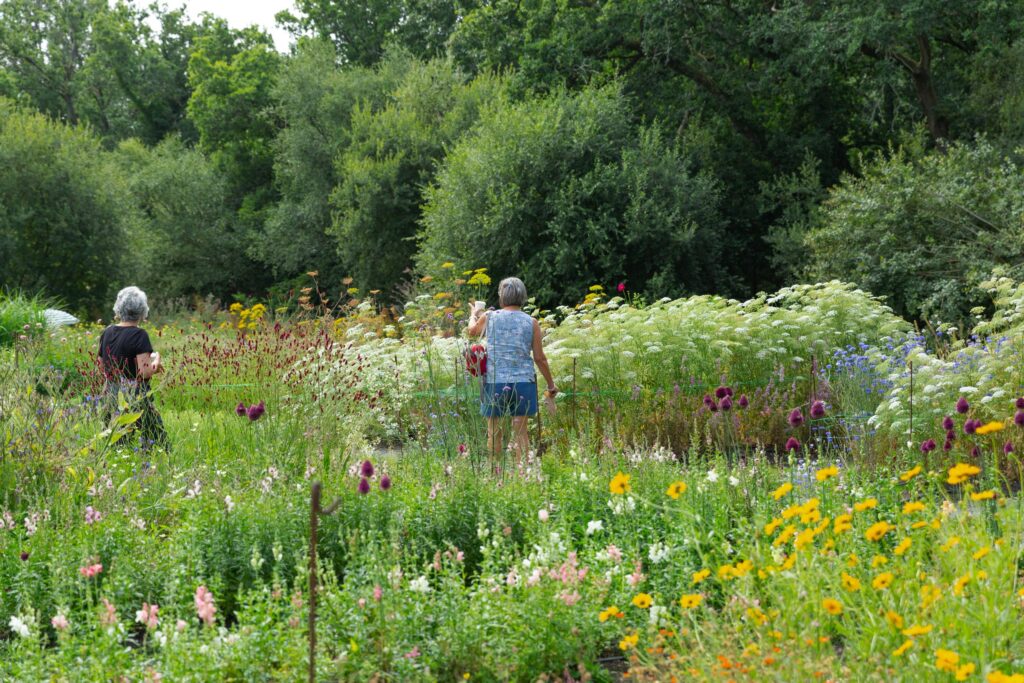
Dan’s best blueberry recipe?
‘Mine must be our Blueberry Smoothie. Combine a handful of organic frozen blueberries with a chunk of banana and a little chunk of ginger. Mix with a big splash of apple juice. Healthy and refreshing.’
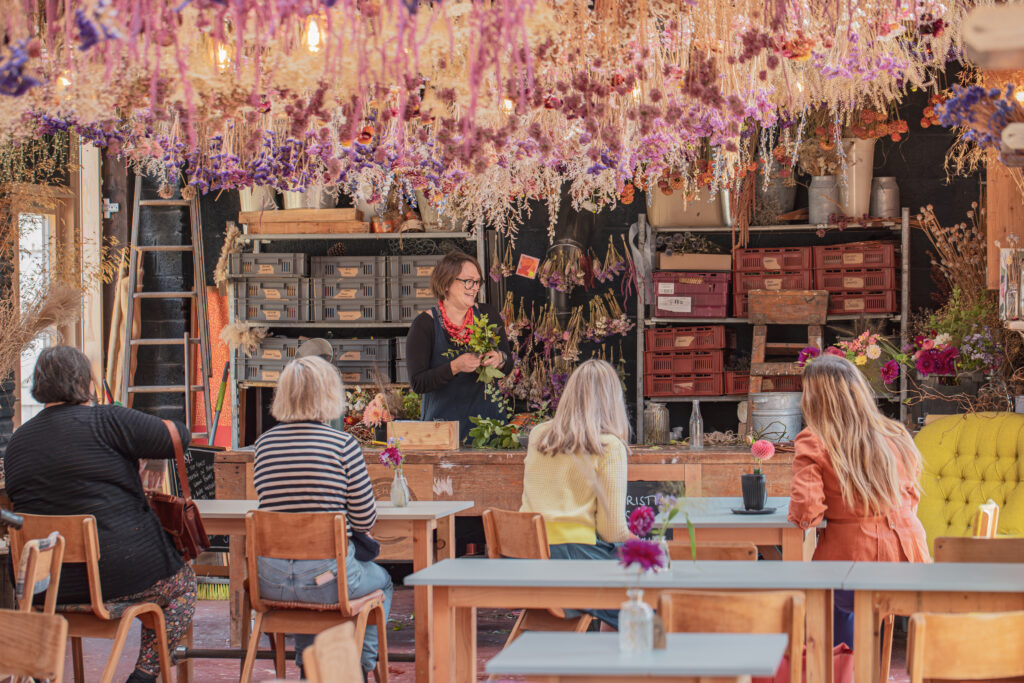
brothersfarm.co.uk
Blueberry PYO and Flower Barn Cafe open
Wed-Sun, 10am to 4pm.
Trehane Nursery,
Stapehill Road, Wimborne, Dorset BH21 7ND
trehaneblueberrypyo.co.uk
This summer, a brand-new event is set to introduce young audiences to the magic of ballet. On Thursday 24th July, Hatch House will host its first Children’s Matinee Performance, supporting the Dicky Buckle Fund – a small charity dedicated to helping emerging dancers and choreographers and widening access to dance for all.
Hosted by acclaimed Bahamian ballerina Courtney Celeste Fox, recently named among Forbes 30 Under 30, this relaxed afternoon has been designed to inspire and entertain. Children will enjoy a special behind-the-scenes look at theatre magic, including lighting effects, music cues and stagecraft. Two short professional ballet performances will follow, before the audience is invited on stage to learn a lively piece of choreography with Courtney herself.
The matinee runs from 3pm to 4.30pm (gardens open at 2.40pm). Picnics are welcome after the show, making it a wonderful family afternoon in the grounds of Hatch House.
It is a rare chance to share the joy of ballet with children in a warm, welcoming setting – whether they’re budding dancers or discovering live performance for the very first time.
Following the matinee, a full dress rehearsal for Ballet Under the Stars will take place from around 5.30pm. Guests who wish to stay are kindly asked to make a suggested donation of £50 per family (the rehearsal is for production purposes and may include long pauses and technical adjustments).
Tickets must be booked in advance, as this is a strictly ticketed event. All proceeds go directly to the Dicky Buckle Fund, supporting the next generation of dance talent.
For more details and booking information, visit dickybucklefund.com.
sponsored by Wessex Internet
I got a call to help break into a neighbour’s home this week. George was elderly, not in the best of health, and his daughter couldn’t get in to check on him. Something was horribly wrong.
One of the nice things about the village is that people materialise from nowhere in a crisis. Someone brought a ladder to get into an upstairs window. A young lad sprinted into the village to get a defibrillator. A mum waited to flag down the emergency services and keep a parking space clear. In rural communities, people come together to help each other.
Whenever I have called 999 it has always been answered immediately – but this time I had to wait to be answered. I was told there would be a wait for a crew because the service was so busy. However, that’s the state of the NHS and ambulance service today.
Then I had to phone back because George deteriorated, and thankfully the call was upgraded. It still took a further 30 minutes – an hour in total – for an ambulance to respond to a category A call (which is supposed to be seven minutes). Naturally, it always feels longer when someone needs help urgently.
The paramedics were calm, proficient and brilliant … and clearly rushing from call to call with barely a break. It’s not their fault. The entire system needs a massive upgrade and investment: and being in a rural area doesn’t help.
And that got me thinking. How can we in rural communities help the situation?
Once the defibrillator was back on charge I reflected on the experience. What would make life easier and safer for the older and more vulnerable people living in our communities, and help them stay independent?
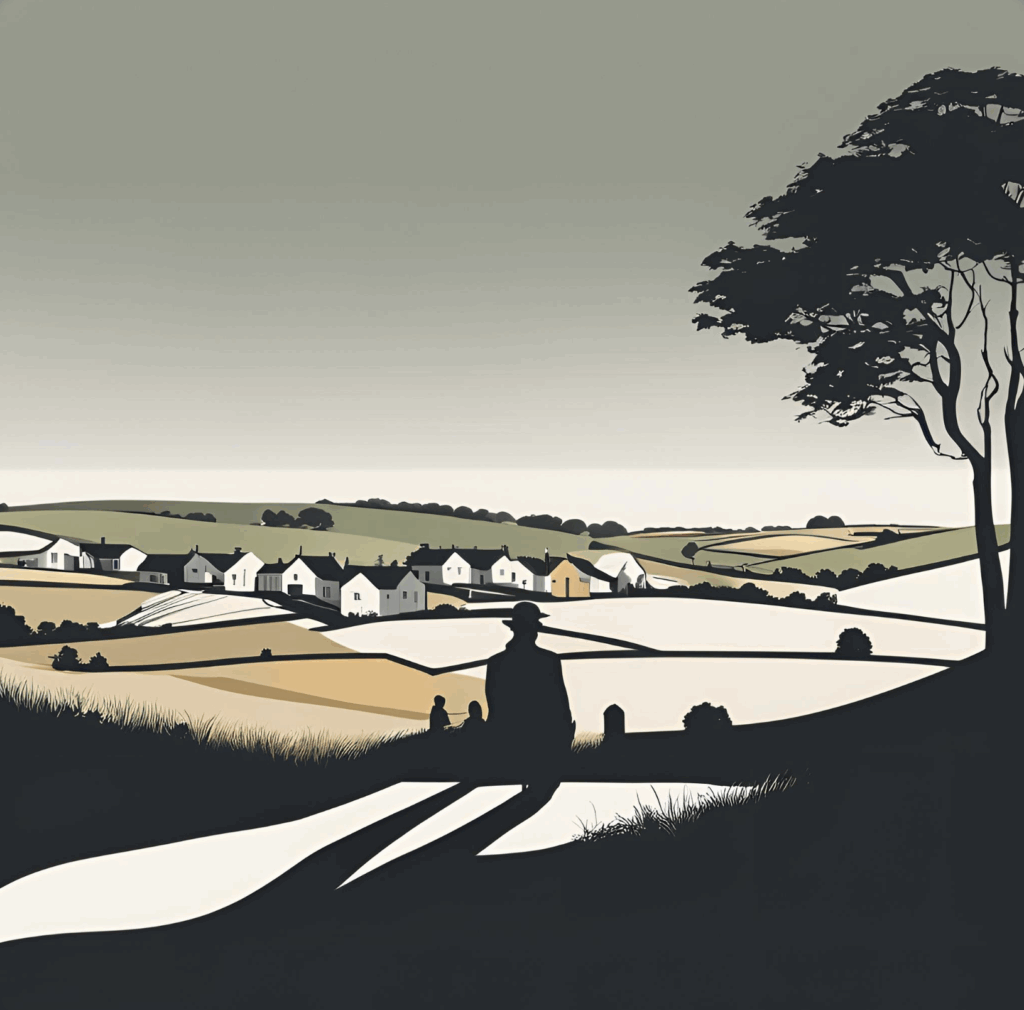
First aid first
Starting with the obvious, would you know what to do if there was a medical emergency? Do you know where your local defibrillator is located, and also how to use it? If not, find out! And look out for first aid training courses. Just moved into a new area? Now’s the time to locate your nearest defibrillator before you get caught short. Most parishes have days when people can familiarise themselves with emergency equipment.
If your parish hasn’t got a defibrillator, it’s time to get one. They save lives. And get it registered so that the emergency services can direct people to it.
Waiting for an ambulance can take significantly longer these days so you may need to think about keeping an injured person comfortable for several hours, or getting help from others to relieve you. Learn some first aid – you never know when it might come in handy.
While we don’t want a neighbourhood watch-like system on steroids, or to be seen as nosey neighbours, how often do we check on those older people around us, particularly those living alone? We struggled to think when we had last seen George – possibly a day ago?
Then we noticed his bin hadn’t been taken out. A subtle clue signalling something was wrong, but seen a bit too late. In a heatwave or really cold weather, checking on elderly neighbours is important. And if a neighbour struggles to get their bin out, offering to help would probably be appreciated. It’s a small way of supporting someone, but can make a big difference. Some local authorities have trackers in the bins of vulnerable people to help detect if they are struggling to use them – which can indicate they are unwell and in need of help.
Where are you?
If there’s an emergency in your home would the paramedics be able to find it? Or do they have to guess at the numbering, the nebulous street signage, or hack their way through an overgrown hedge? Making sure your house has a clear number or name and can be accessed without causing another accident saves valuable time in an emergency, – especially when ambulance crews are trying their best to get to you as fast as possible. This is particularly important in rural areas during winter where there is no street lighting. What3Words is an excellent app for locating an accident, such as in a field, but it’s just as useful for tricky nebulous rural addresses to help the emergency services find you.
No taxi service
Then there’s the living space. Watching the paramedics get George down a steep flight of stairs with piles of monitoring equipment was a sober lesson in why we should be building more adaptable and accessible accommodation, and supporting those in inappropriate homes to relocate to something more suitable. And for every building developer saying no, they should be made to lower a stretcher with a 16 stone person down a narrow stairway. What a nightmare these places are in an emergency.
And that’s before we reflect on what a struggle it must have been for George to get up and down those stairs in the first place.
Finally, only call 999 for an ambulance when you really need it. There are alternatives, such as NHS 111 and a local pharmacy for minor problems. Paramedics are highly trained professionals: they are the salt of the earth and will bend over backwards to help in an emergency. However, they do not run a taxi service.
The Dorset Insider is a no-holds-barred column pulling back the curtain on local affairs with sharp insight, unfiltered honesty and the occasional raised eyebrow. Written by a seasoned parish councillor who prefers to remain anonymous (for obvious reasons), it cuts through the noise to expose the frustrations of grassroots politics, and say what others won’t. Rest assured, their identity is known – and trusted – by the editorial team. Expect opinion, candour and a healthy dose of exasperation …